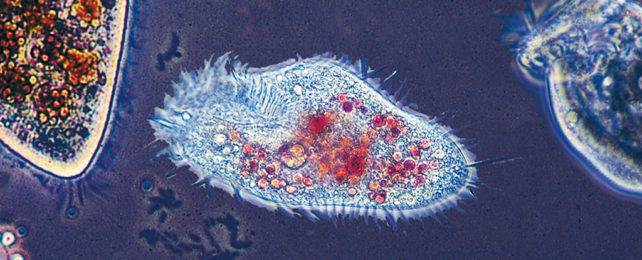Tiny single-celled critters obviously don't have room for a brain to tell them how to move in complex ways, so to get about, they usually roll, slither or swim.
But microscopic pond dwellers called Euplotes eurystomus have mastered a way to walk brainlessly – scurrying about like insects, with their 14 little appendages.
They appear to move a bit like the Dutch-designed kinetic sculptures called Strandbeasts, with clockwork-like connections cycling them through a pattern of set states that can be adjusted in response to their environment.
"There seemed to be this sequential logic happening with the movements," says biophysicist Ben Larson from the University of California, San Francisco (UCSF). "They weren't random, and we began to suspect there was some sort of information processing happening."
These protozoans – single-celled organisms with animal-like characteristics – have 14 stingy bundles of cilia that work together as legs called cirri. They can use these cirri to swim and walk while actively hunting for prey.
This all started in the 2016 @MBLPhys course during my PhD with @Choano_Lab. I had noticed predatory critters eating the choanoflagellates I was trying to isolate from field samples. Knowing Wallace to be an expert on crazy microorganisms, I struck up a conversation...
— Ben Larson (@BEuplotes) March 1, 2021
2/n pic.twitter.com/R4jRwOAWhQ
Larson and colleagues captured microscopic footage of these tiny predators to study their movements in slow motion. The researchers identified 32 different combinations of leg movements and found certain combinations were more likely to follow each other.
The cirri are made of tubulin fibers, like the rest of the cell's scaffolding structures (its cytoskeleton). These fibers also act as a support structure between the different cirri so they also function as a kind of mechanical communication.
"Euplotes uses these connections to facilitate an elaborate walking motion, " explains UCSF biophysicist Wallace Marshall.
Computer modeling revealed that tension and strain on the fibers dictated which set pattern of cirri positions was possible at each moment. Some cirri store stress at different stages of a gait; when that stress is released it propels the cell to move forward into the next state, causing a cyclic transition between these states.
"The fact that Euplotes' appendages are moving from one state to another in a non-random way means this system is like a rudimentary computer," says Marshall.
When the researchers exposed Euplotes to a drug that disrupts the synchronous reactions of the tubulin fibers it dysregulated the cell's gait, causing the poor critters to walk in futile circles.
Their gait still remained regular, but it was no longer coordinated in a way that allowed for effective motion. The clockwork connections between appendages could no longer be wound up and reset to keep the cell ticking onwards.

So rather than brains and nerves, these single-celled creatures are controlled by networks of signaling molecules. We've seen previously how such systems can achieve surprisingly complex behaviors in microbes like decision-making, learning, and navigating mazes.
"This is a really fascinating biological phenomenon itself, but also could highlight more general computational processes in other types of cells," says Larson.
There's still a lot more to understand about the mechanistic workings of this locomotive system, but now we can add walking to the list of examples of how random molecular processes can be harnessed to create sequential behaviors.
This research was published in Current Biology.
